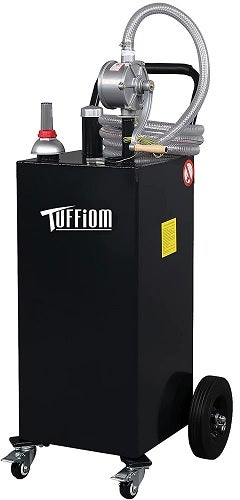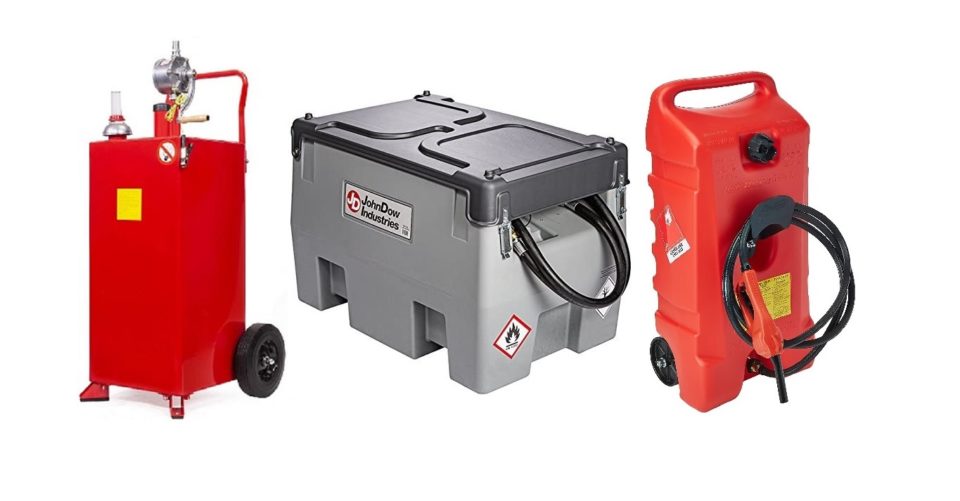
Our Editors independently research, test, and rate what we feel are the best products. We use affiliate links and may receive a small commission on purchases.
Are you tired of filling gas cans to fuel your gas-powered tools or vehicles? Save yourself time and money by investing in a good-quality gas caddy. Also known as a fuel caddy or fuel transfer tank, you can make one trip to the gas station with these to get all the fuel you need for the week, depending on your consumption level. Many caddies are fitted with a convenient electric pump that makes refuelling your vehicle, ATV or boat or fast and convenient. A gas caddy is the perfect solution to store fuel so you have a little extra on hand whenever you need it.
For more of my vehicle accessories recommendations, have a look through these popular Outside Pursuits guide links: Utility Trailers, Floor Jack, Loading Ramps.
Quick Answer: The Best Rated Gas Caddies
- John Dow Industries JDI-AFT58
- Scepter Flo-N-Go DuraMax Fuel Caddy
- Arksen 30 Portable Gas Caddy
- John Dow Industries JDI-FST15
- TUFFIOM Portable Gas Caddy Tank
Gas Caddy Reviews
#1 Editor’s Choice – John Dow Industries JDI-AFT58
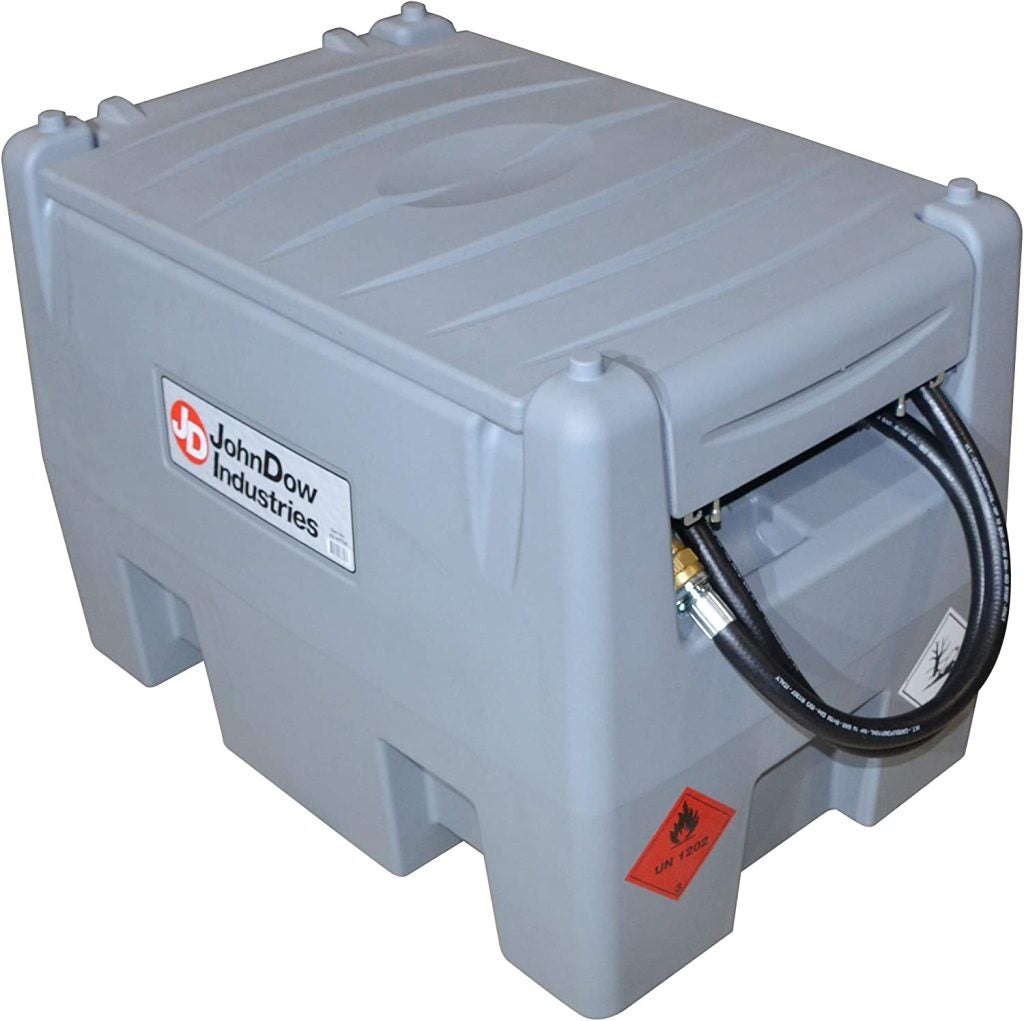
- Capacity: 58 Gallons
- Fuel Type: Diesel
- Wheeled: No
- Pump: 12V Electric Pump
When you purchase a portable diesel tank, you’re buying a product that is potentially dangerous. It’s also an expensive purchase, and it may be vital to your business that it works as it should. So, you have to be confident that you’re buying a good quality product from a reputable manufacturer. John Dow Industries has manufactured automotive products for over 35 years, and they’re one of the market leaders in gas can, fuel caddy and gas tank manufacturing. It’s a name you can trust. The John Dow Industries JDI-AFT58 is a fantastic portable diesel tank that you can strap to the bed of your pick up truck and drive anywhere. It’s a self-contained unit with a 12V pump, 13-foot hose and automatic nozzle. The pump can provide diesel at a rate of 10 gallons per minute. It’s like taking a portable gas station with you when you go to work!
This portable diesel tank is made of durable polyethylene. The protective cover is lockable for extra security, and its design includes recesses for ratchet straps to secure your tank inside your truck bed. Built-in forklift pockets enable it to be moved by a forklift when the tank is full, and when empty, this portable tank only weighs 56 lbs. For such occasions, molded handles enable you to lift and carry it by hand. It’s important to mention that this portable gas tank is designed for diesel only. The pump included is not designed to be used with more volatile fuels such as gasoline. But for commercial users who must refill a lot of diesel tanks and need to travel to get to them, this portable diesel tank is ideal.
#2 Best for Boats – Scepter Flo-N-Go DuraMax Fuel Caddy
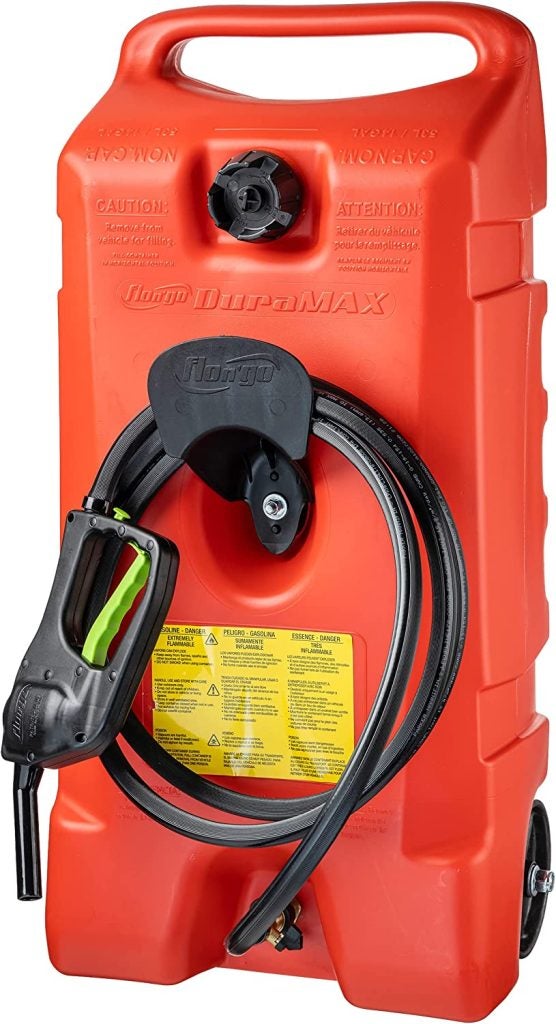
The Scepter DuraMax Flo ‘n’ Go is the smallest fuel transfer tank in this review with a capacity of 14 gallons. It’s also the most affordable, at less than twice the price of the equivalent metal 15-gallon option from John Dow below. But, the reason for its low price is not low quality. In fact, this well-designed but small fuel caddy is UL-Approved and meets all DOT requirements. It’s made from durable, high-density polyethylene which is a far cheaper material than the metal used in other gas caddies. This caddy is suitable for a wide range of uses, both residential and commercial. With its sturdy, 6″ wheels and heavy-duty and ergonomic top handle, it’s still portable even when full. Because of the durable plastic shell, it’s lightweight and especially suitable for marine use. The Flo n’ Go comes with a 10-foot hose and is suitable for gasoline, kerosene or diesel. It utilizes DuraMax’s proprietary Flo ‘n’ Go hand pump. With dual mechanical shut-off valves, the disconnection is clean. The hose is designed to connect with standard 1/4 NPT marine tank fittings. That means no fuel will end up in the water causing pollution that nobody wants to see. This fuel transfer tank is also designed for easy storage. Recessed grooves are positioned to enable easy strapping, and there’s a bolt-on hanger for secure hose storage. The DuraMax Flo ‘n’ Go is one of the best gas caddies for a boat. It’s perfect for refuelling your outboard motors and can safely be stored on board. This versatile and durable metal caddy can be used to store fuel of any kind — gasoline, diesel, kerosene or biodiesel. Not only can the attached 2-way rotary pump be used to pump fuel into a vehicle tank, it can also remove it when you need an empty tank for maintenance (or if you need to remove degraded or contaminated fuel). To change the direction of the fuel in the hose, simply change the direction you’re turning the crank. The pump is equipped with an 8-foot hose to aid dispensing. If you’re not using the pump to fill it up, you can utilize its easily accessible fill neck. With its wide diameter, this fuel inlet enables you to fill the fuel caddy without spills or waste. The Arksen 30 Portable Gas Caddy lives up to its name with 2 rear wheels that make it very portable and 2 front casters fitted with brakes. The solid rubber tires will keep down static, and an anti-static ground clamp provides extra protection. This fuel transfer tank is suitable for marine, agricultural, workshop and residential purposes. It can safely store up to 30 gallons of fuel for any purpose. However, 30 gallons will only fill 2 average car gas tanks. So, if you’re expecting to store enough to keep 5 cars on the road, or if you need to fuel agricultural machinery, you should look for a larger option. If you’re a motorcycle enthusiast with a few hogs to feed, or if you own a vast collection of yard maintenance tools, the John Dow Industries JDI-FST15 is a handy fuel transfer tank to keep around. It’ll save you many trips to the gas station and safely store your gas for long periods of time. Made from durable welded steel, it will last you a lifetime. It;’s UN/DOT approved, so you know it’ll be safe to both store and transport your gas in this container. Safety was the main priority in its design, and it even incorporates a safety shut off valve in its design. It was actually originally designed for bolting onto a trailer for people who want to carry a little extra fuel when they travel, just to be on the safe side. However, its 4 welded feet allow it to be stored on the floor without touching it, which is safer for long-term storage. However, this caddy doesn’t utilize a pump for dispensing fuel. Instead, it relies on a gravity feed system to fill your yard maintenance tools or gas tanks. With a name like John Dow Industries, you know you’re buying a quality product. It all depends on whether you prefer a metal or plastic tank. The JDI-FST15 is much more expensive than the comparable Scepter DuraMax Flo-N-Go reviewed above, which also features a manual pump. But this product is metal, and the former is polyethylene. If you’re storing fuel to refill multiple yard maintenance tools many times over, this gas caddy is ideal. For most keen gardeners, 35 gallons is ample storage space. This fuel caddy boasts all the same features as more expensive ones, including the versatile 2-way pump that enables you to fill a vehicle’s fuel tank, or empty it as needed. It can contain any fuel type you want, including gasoline, diesel, kerosene or biodiesel. Its metal construction and built-in vent means you can store gas for a long time. However, you should pre-treat any stored gas with a stabilizer if you plan to use it more than 6 months after storing it. The pump comes with an 8-foot kink-free hose that easily fits any gas tank. When filling this fuel caddy without the pump, the wide fill neck enables you to fill the caddy without spills and mess. The clever visual level gauge enables you to check the fuel level whenever you need. For safety, it also comes with an anti-static ground clamp. The 10″ solid-rubber tires enable you to move this caddy around with ease. It even has the casters with brakes that more expensive models have. If 35 gallons is enough storage space for your needs, the TUFFIOM Portable model is a versatile solution to your fuel storage needs. It’s by far one of the best 35-gallon options on the market today. Now that you’ve learned all about the top-rated gas caddies on the market, you may have already decided which is best for you. But if you want to learn more before making your choice, the following guide is for you. Let’s look at the key characteristics of a good fuel transfer tank. Understanding the importance of each characteristic will help you make an informed choice about which one is best for you, your home and/or your business. Sometimes a jerrycan just isn’t large enough for your fuel requirements. That’s when a gas caddy comes in handy. A gas caddy is a fuel container that falls between an industrial fuel tank and a gas can in size. One of these typically stores between 3 and 10 times the amount of fuel held inside an average gas can. Although a fuel caddy can’t store as much fuel as a full-sized industrial fuel tank, it offers the huge advantage of being portable, so you can take the fuel where it’s needed. Farmers who want to refuel their tractors and other agricultural machines out in the fields, racing drivers who want to refuel quickly on the racetrack, and householders who own a large number of gas-fuelled yard maintenance tools all find gas caddies useful. Gas caddies typically range in size from 15 gallons to 60 gallons. This is a much larger capacity than gas cans, which typically hold up to 5 gallons. Before deciding which one is best for you, you should have a clear idea about how much fuel you want to store. This will depend upon the number of machines you own that require gas or diesel to operate and the size of their fuel tanks. If you’re a farmer, you probably have several large agricultural machines to fill and would benefit from a large 60-gallon caddy that you can transport in your truck bed. If you have a large yard and own a lot of maintenance tools, such as backpack leaf blowers and gas-powered chainsaws, you’ll benefit from a fuel transfer tank. However, because they have small tanks and won’t consume as much gas as a tractor, you may want a smaller caddy. Some prefer to have a large caddy ready for when fuel hikes are likely. When they hear rumors of an imminent price increase, they fill their fuel transfer tank to the brim to take advantage of the cheaper gas while it’s still available. Different kinds of fuel have different chemical compositions. That means they’ll react to the materials used to manufacture gas caddies in different ways. Because of this, some gas caddies are only designed to store one kind of fuel. Others are more versatile and can contain a wide range of fuel types. Before you buy a fuel transfer tank, ensure that it’s compatible with the kind of fuel you want to store. If you choose different kinds of fuel, you have to use a different fuel caddy for each kind of fuel and label them clearly. Many fuel caddies are sold in specific colors to make this easy. For example, fuel caddies designed to store diesel are typically black. If you store the wrong kind of fuel in a caddy, there’s a chance it will quickly degrade. If the degradation is bad, it could even cause damage to your engines. Many of the smaller gas caddies come equipped with wheels. This makes them much easier to move around. The larger gas caddies are too heavy for a single person to move safely. These are often fitted with special integrated forklift pockets on their base, so they can be lifted by a forklift truck when full. Many people who require the larger gas caddies for their outdoor work install them onto their truck bed, so that the fuel can be easily transported to where it’s needed. Many gas caddies use a pump to deliver fuel to your engine’s gas tank, and sometimes also to remove fuel. Many operate in both directions. Smaller gas caddies typically utilize a manual pump powered by a handle, while larger or more sophisticated gas caddies use a 12V electric pump powered by a rechargeable battery. A few more affordable gas caddies rely on a gravity feed to fill your machine’s gas tanks In many countries and states, there are strict laws regarding the storage of fuels. The DOT and EPA both set out regulations concerning gas caddies, and there are other government departments and State Fire Marshals that take a strong interest. The nationally recognized testing facility is United Laboratory (UL). If you purchase a fuel caddy that is UL Certified, it will meet both DOT and EPA standards. Do not purchase one that has not been certified as safe to use by your local government’s relevant agencies. Not only are you putting yourself at risk, but you also risk facing legal consequences for breaking the law. This is not a significant issue for most people. However, the nozzle on the pump provided may not be compatible with the intake of the fuel tank on some machines. If some of your machines require a special connection to accept fuel, make sure that the pump nozzle that comes with your chosen caddy is compatible with that connection. Otherwise, you won’t be able to use your fuel caddy to refuel those machines. Gas caddies are constructed from either metal or plastic. Each material has its own pros and cons. You must decide which material is most compatible with your requirements. Plastic gas caddies are typically more affordable than metal. On average, metal gas caddies are twice the price of plastic gas caddies of comparable size. When gas is stored inside a plastic container for a long time, the fuel can react with the plastic. This may compromise the gas caddy’s integrity and degrade the fuel, as we’ve mentioned above. So, if you plan to store the fuel for a long time, metal is generally preferable. However, in the event of a fire, a plastic container is arguably safer. A plastic container will melt, but a metal container will explode like a bomb, potentially causing significant property damage and personal injury. One of the reasons for using a fuel caddy rather than an industrial fuel tank is that it’s portable. Plastic is lighter than metal, so plastic gas caddies are typically easier to transport than metal gas caddies. Record how much gasoline all your machines consume over a set time period, such as a week. Decide how often you want to visit the gas station. Ensure that the caddy you purchase can store more fuel than all of your machines require for the time period you choose. Buy a different fuel caddy for each kind of fuel you use, and make sure they’re different colors and are clearly labeled. Don’t be tempted to buy one and fill it with diesel one day and gasoline the next. That’s a recipe for disaster, which we explained in further detail above. Before you splash out lots of money for the biggest caddy you can afford, check out the local gasoline storage regulations. It’s possible that there’s a set limit to how much gasoline can be stored on your property. It’s also likely that only gas caddies that have been approved by government departments such as the DOT are permitted. Don’t risk legal consequences by storing fuel in ignorance, only to later discover that you’ve broken several laws and may face prosecution. Here is a video with a few more tips about how to store gasoline long term
#3 Best Portable – Arksen 30 Portable Gas Caddy
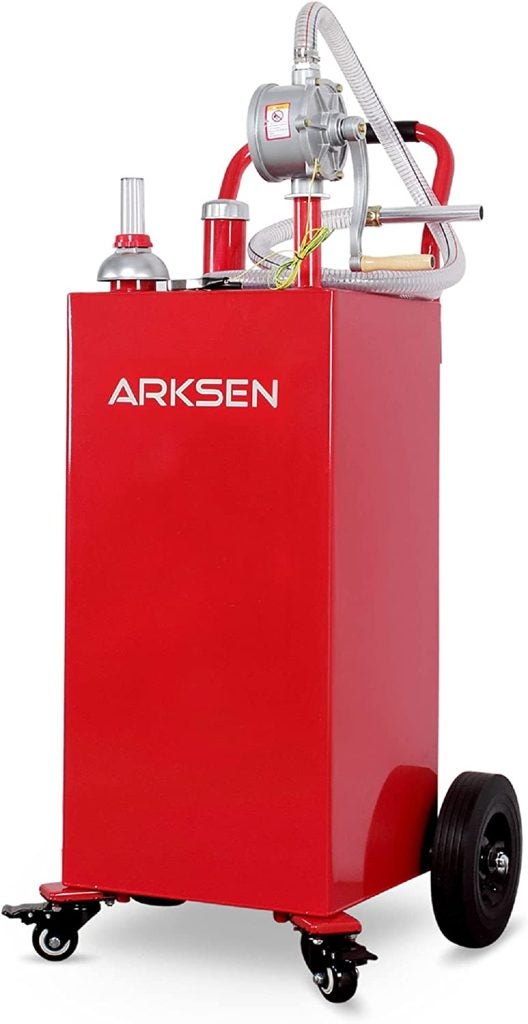
#4 Customer’s Choice – John Dow Industries JDI-FST15
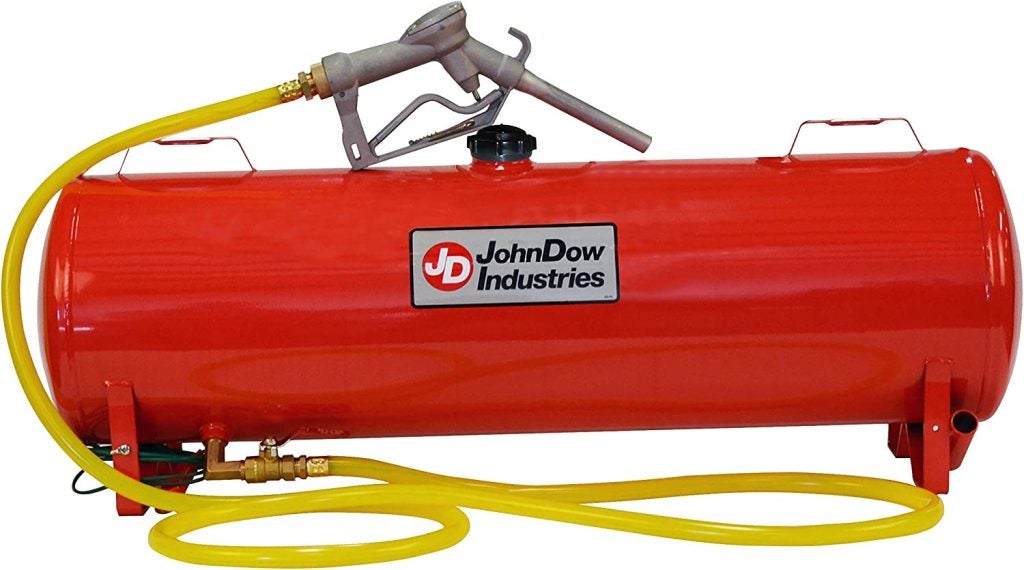
#5 Best 35-Gallon – TUFFIOM 35 Gallon Portable Gas Caddy
How to Choose the Best Gas Caddy – Buying Guide
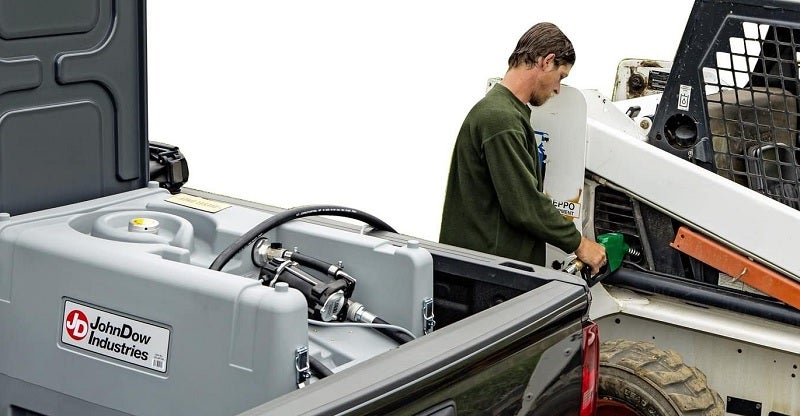
What is a Gas Caddy?
Capacity
Fuel Type
Portability
Pump
Safety
Compatibility
Material — Metal Vs Plastic
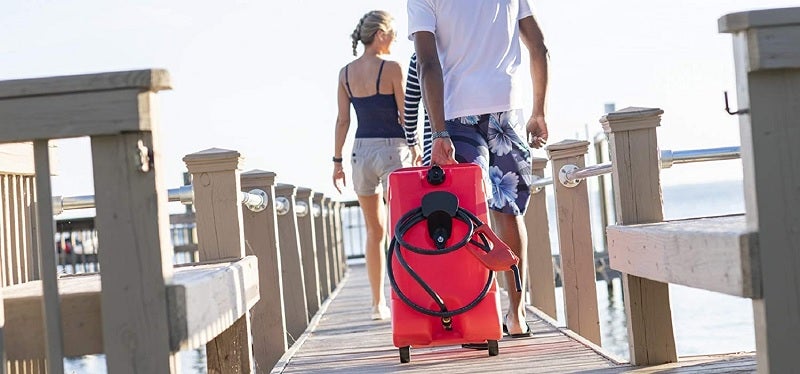
Tips For Choosing Gas Caddies
#1: Make sure the gas caddy is big enough for your needs
#2: Buy more than one gas caddy
#3: Check with your local Fire Department first
Conclusion
Thanks for reading our buyer’s guide and review! I hope that you now feel confident about choosing the best gas caddy for your home or business. Gas caddies can save you a lot of time and money if you select one that’s ideal for your personal needs. You won’t have to make as many trips to the gas station, and you can stock up on gas when the price is about to shoot up, which can save you a ton in the long run!
FAQs
How does a gas caddy work?
A gas caddy can be filled at a gas station or from a fuel tank, then easily transported to where the fuel is needed. This is useful in situations where you can’t easily move your vehicles to the gas station, or if you have multiple machines that will require fuelling multiple times. Gas caddies also incorporate a delivery device so they can fill your gas tanks. This may be a simple gravity feed, a manual pump or electric pump.
How long can you store gasoline in a plastic container?
Gas will last up to 6 months inside a clean, airtight plastic fuel transfer tank. For safety, this should be a government-certified plastic fuel container and labeled correctly. However, during this storage time, the gasoline will degrade and lose some volatility. For long term storage, a metal fuel caddy is recommended.
What is the best way to store gasoline long term?
Do not store gas inside your home or inside any attached outbuildings, such as an integral garage. Wherever you store your gas or during handling, keep a B-rated fire extinguisher handy just in case. Gas must be stored in a well-ventilated area that is far away from an open flame (such as a pilot light) or electrical equipment. The storage area must be secure. Ideally, you should have a proper storage cabinet for fuel that is robust and flame resistant. Alternatively, a shed or detached garage can be used to store gas caddies. It must be stored in State Fire Marshal or UL approved gas caddies.
Can I store my gas can outside?
No, not in the open air. This is because neighbouring children or nosy adults might find your fuel transfer tank interesting, and you may be liable for the consequences of someone tampering with your tank.
Are metal or plastic gas cans better?
Metal gas cans are better for long term storage, while plastic gas cans are more affordable and are better for short term storage. They’re also significantly lighter, so plastic cans are recommended for easy transportation.
How do you keep gasoline from going bad?
You can add a fuel stabilizer before storage. Fuel stabilizers are petroleum-based additives that increase your fuel’s lifespan. Theoretically, gasoline with an added fuel stabilizer will last for up to 3 years. Note that fuel stabilizers have no effect on old gasoline. They can’t resurrect gas that has degraded, they can only prevent new gas from degrading in the future.
Recent Updates
April 20, 2022: Verified availability of all products and updated product specifications for currency.
How We Researched
To come up with the top gas caddies, we researched a variety of sources for reviews such as Camping World, Lazy Days, Real Truck and Walmart along with our own personal experience. We also consulted online magazines for product research and reviews to get as much unbiased information as we could. To help weed out fake reviews we used Fakespot.com to make sure we only looked at genuine reviews. With so much quality gear available, we had to narrow it down based on what we felt were the best options for the price.
The staff authors have a wide and varied background in RV camping, automotive repairs and backpacking. The authors have decades of experience and are eager to share their knowledge with readers. To help narrow down the selection we used personal experiences along with recommendations from mechanics and retailers. After extensive research, we came up with our list to help you choose the right one for you.

